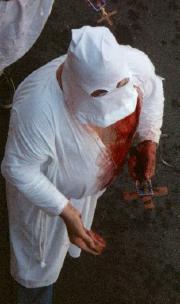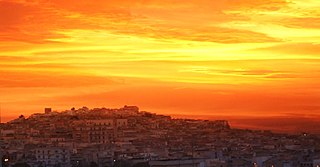
Canosa di Puglia, generally known simply as Canosa, is a town and comune in the province of Barletta-Andria-Trani, Apulia, southern Italy. It is located between Bari and Foggia, on the northwestern edge of the plateau of the Murgia which dominates the Ofanto valley and the extensive plains of Tavoliere delle Puglie, ranging from Mount Vulture at the Gargano, to the Adriatic coast. Canosa, the Roman Canusium, is considered the principal archaeological center of Apulia, and is one of the oldest continually inhabited cities in Italy. A number of vases and other archaeological finds are located in local museums and private collections. It is not far from the position on the Ofanto River where the Romans found refuge after the defeat of the Battle of Cannae and is the burial place of Bohemund I of Antioch.

The Province of Caserta is a province in the Campania region of southern Italy. Its capital is the city of Caserta, situated about 36 kilometres (22 mi) by road north of Naples. The province has an area of 2,651.35 square kilometres (1,023.69 sq mi), and a total population of 924,414 as of 2016. The Palace of Caserta is located near to the city, a former royal residence which was constructed for the Bourbon kings of Naples. It was the largest palace and one of the largest buildings erected in Europe during the 18th century. In 1997, the palace was designated a UNESCO World Heritage Site.
San Lupo is the name of a hill town and comune in the province of Benevento, in the Campania region of southern Italy. It is a member of the Titerno "Local Action Group".
San Lorenzo Maggiore is a town and comune in the province of Benevento, in the Campania region of southern Italy. It is a member of the Titerno Local Action Group.
Telese Terme, called simply Telese until 1991, is a city, comune (municipality) and former episcopal seat in the Province of Benevento, in the Campania region of southern Italy. It is located in the valley of the Calore, well known for its sulfuric hot springs.
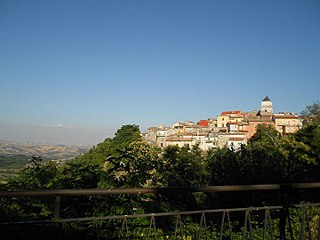
Guardia Lombardi, known as La Uàrdia in the Guardiese dialect or Guardiae Longobardorum in Latin, is a small town and comune in the Province of Avellino in Campania, Italy. At an elevation of 998 metres (3,274 ft), it is located in Alta Irpinia in the Apennine Mountains of Southern Italy. It has experienced a number of major earthquakes throughout its history that have devastated the town, and is considered within zone 1 of the Protezione Civile's seismic classification index, indicating very high seismicity.

Rocca San Felice is a town and comune in the province of Avellino, Campania, southern Italy.

Sant'Angelo dei Lombardi is a town and comune in the province of Avellino in the Campania region of southern Italy. It has been a historical spot of significance in mezzogiorno history.
Riccia is a comune (municipality) in the Province of Campobasso in the Italian region of Molise, located about 15 kilometres (9 mi) southeast of Campobasso, with a population of about 5,600.

Cerreto Sannita is a comune (municipality) in the Province of Benevento in the Italian region Campania, located about 60 km northeast of Naples and about 25 km northwest of Benevento.

Fragneto Monforte is a comune (municipality) in the Province of Benevento in the Italian region Campania.

Morcone is a comune (municipality) in the Province of Benevento in the Italian region Campania, located about 70 km northeast of Naples and about 25 km northwest of Benevento. The villages (Contrade) of Morcone include: Canepino, Cuffiano, Coste, Torre, Fuschi, Piana.

Pietraroja is a mountain comune (municipality) in the province of Benevento in Campania, southern Italy. It is approximately 50 km by car from Benevento, in direction north-west, 83 km from Naples in direction north-east and approximately 223 km from Rome in direction south-east.

San Lorenzello is a comune (municipality) in the Province of Benevento in the Italian region Campania, located northeast of Naples and about 25 kilometres (16 mi) northwest of Benevento.

San Salvatore Telesino is a comune (municipality) in the Province of Benevento in the Italian region Campania, located about 50 kilometres (31 mi) northeast of Naples and about 25 kilometres (16 mi) northwest of Benevento.

Novara di Sicilia is a comune (municipality) in the Metropolitan City of Messina in the Italian region of Sicily, located about 160 kilometres (99 mi) east of Palermo and some 40 kilometres (25 mi) southwest of Messina.
Poggio Sannita is a comune (municipality) in the Province of Isernia in the Italian region Molise, located about 30 kilometres (19 mi) northwest of Campobasso and about 25 kilometres (16 mi) northeast of Isernia. Poggio Sannita is on a promontory surrounded by the Verrino and Sente rivers, both mostly torrential in character, especially the latter, which dries up completely during the summer.
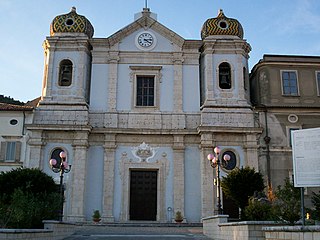
The Italian Catholic Diocese of Cerreto Sannita-Telese-Sant'Agata de' Goti, in Campania, Italy, has existed since 1986, when the Diocese of Sant'Agata de' Goti was united into the historical Diocese of Telese-Cerreto Sannita. The diocese is a suffragan of the Archdiocese of Benevento.
The 1688 Sannio earthquake occurred in the late afternoon of June 5 in the province of Benevento of southern Italy. The moment magnitude is estimated at 7, with a Mercalli intensity of XI. It severely damaged numerous towns in a vast area, completely destroying Cerreto Sannita and Guardia Sanframondi. The exact number of victims is unknown, and is estimated at about 10,000. It is among the most destructive earthquakes in the history of Italy.
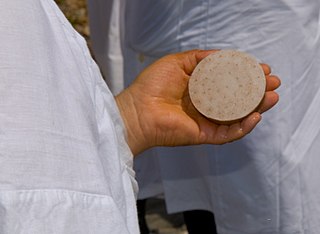
A spugna is an instrument of penance used by some Christians who practice mortification of the flesh. With the word "spugna" literally meaning "sponge", spugnas are made from circular shaped cork that contains metal studs, metal spikes, or needles. Christians, especially those who are enrolled in a confraternity of penitents, strike the spugna against their chests to repent of sins and to share in the Passion of Christ. Spugna are used in the privacy of one's dwelling, as well as in public Christian processions. When in public, beaters (battenti) cover their faces with capirote in order to not draw attention to themselves as they repent, but to God; these include men, women and children. As those using the spugna sometimes bleed, white wine is poured on top of the spugna to cleanse it and protect the wound from infection.





